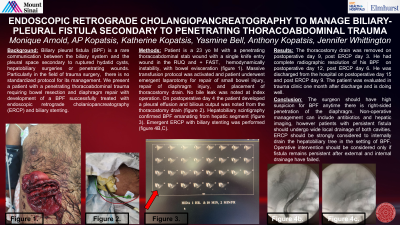Trauma
Category: Quickshot Oral Session 24
Quickshot Oral : Quickshot Oral Session 24
ENDOSCOPIC RETROGRADE CHOLANGIOPANCREATOGRAPHY TO MANAGE BILIARY- PLEURAL FISTULA SECONDARY TO PENETRATING THORACOABDOMINAL TRAUMA
Tuesday, February 14, 2023
7:00am - 8:00am East Coast USA Time

- JW
Jennifer Whittington, MD, PhD
General Surgeon
Mount Sinai, United States - JW
Jennifer Whittington, MD, PhD
General Surgeon
Mount Sinai, United States
Presenter(s)
Principal Contact(s)
Objectives: Biliary pleural fistula (BPF) is a rare communication between the biliary system and the pleural space secondary to ruptured hydatid cysts, hepatobiliary surgeries or penetrating wounds. Particularly in the field of trauma surgery, there is no standardized protocol for its management. We present a patient with a penetrating thoracoabdominal trauma requiring bowel resection and diaphragm repair with development of a BPF successfully treated with endoscopic retrograde cholaniopancreatography (ERCP) and biliary stenting.
Methods: Patient is a 23 year old undomiciled man brought in by EMS on 8/5/2022 after sustaining a penetrating thoracoabdominal stab wound with a single knife entry wound in the right upper quadrant. Patient noted to have a positive focused assessment with sonography for trauma, hemodynamically instability, with bowel evisceration. Massive transfusion protocol was activated and patient underwent emergent laparotomy for repair of small bowel injury, repair of diaphragm injury, and placement of thoracostomy drain (figure 1A). No bile leak was noted at index operation. On postoperative day 4 the patient developed a pleural effusion and bilious output was noted from the thoracostomy drain. Hepatobiliary scintigraphy confirmed BPF emanating from hepatic segment 7. Emergent ERCP with biliary stenting was performed (figure 1B,C).
Results: The patient's thoracostomy drain was removed on postoperative day 9, post ERCP day 3. He had complete radiographic resolution of his BPF on postoperative day 12, post ERCP day 6. He was discharged from the hospital on postoperative day 15 and post ERCP day 9. The patient was evaluated in trauma clinic one month after discharge and is doing well.
Conclusion: The surgeon should have high suspicion for BPF anytime there is right-sided penetration of the diaphragm. Non-operative management can include antibiotics and hepatic imaging, however patients with persistent fistula should undergo wide local drainage of both cavities. ERCP should be strongly considered in order to internally drain the hepatobiliary tree in the setting of BPF. Operative intervention should be considered only if fistula remains persistent after external and internal drainage have failed.
Methods: Patient is a 23 year old undomiciled man brought in by EMS on 8/5/2022 after sustaining a penetrating thoracoabdominal stab wound with a single knife entry wound in the right upper quadrant. Patient noted to have a positive focused assessment with sonography for trauma, hemodynamically instability, with bowel evisceration. Massive transfusion protocol was activated and patient underwent emergent laparotomy for repair of small bowel injury, repair of diaphragm injury, and placement of thoracostomy drain (figure 1A). No bile leak was noted at index operation. On postoperative day 4 the patient developed a pleural effusion and bilious output was noted from the thoracostomy drain. Hepatobiliary scintigraphy confirmed BPF emanating from hepatic segment 7. Emergent ERCP with biliary stenting was performed (figure 1B,C).
Results: The patient's thoracostomy drain was removed on postoperative day 9, post ERCP day 3. He had complete radiographic resolution of his BPF on postoperative day 12, post ERCP day 6. He was discharged from the hospital on postoperative day 15 and post ERCP day 9. The patient was evaluated in trauma clinic one month after discharge and is doing well.
Conclusion: The surgeon should have high suspicion for BPF anytime there is right-sided penetration of the diaphragm. Non-operative management can include antibiotics and hepatic imaging, however patients with persistent fistula should undergo wide local drainage of both cavities. ERCP should be strongly considered in order to internally drain the hepatobiliary tree in the setting of BPF. Operative intervention should be considered only if fistula remains persistent after external and internal drainage have failed.

